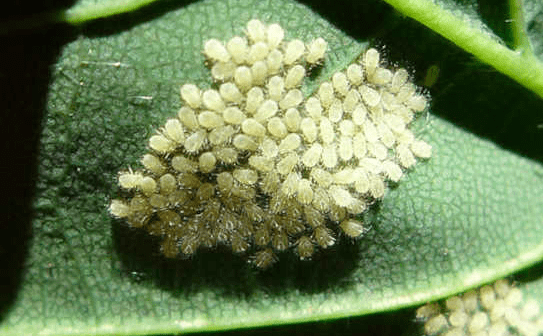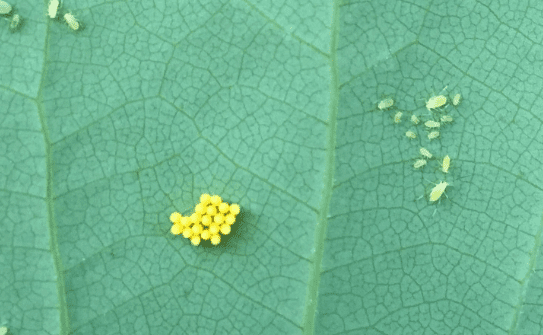Do you ever look at leaves and wonder why they have yellow eggs on them? No? Just me then. Well, regardless of whether or not you’ve ever wondered about it, today we’re going to explore the answer! What are these eggs, anyway? And what do they do? Keep reading to find out!
Why Are There Yellow Eggs on Leaves?
The yellow eggs you see on leaves are most usually from moths, beetles, aphids, and stink bugs. The female insect lays them there so that her offspring will have food when they hatch, which is why you’ll often see them near the edges of leaves. The eggs are usually yellow or green, and they’re laid in groups so that the larvae can feed on the leaf tissue together.
These eggs will hatch and the larvae will start to eat the leaf, which can cause damage to the plant. In some cases, the larvae will even bore into the stem of the plant, which can kill it. The good news is that there are predators that like to eat these eggs, so they don’t always have a chance to hatch and do their damage.
What Insect Lays Yellow Eggs on Leaves?
Moths, beetles, aphids, and stink bugs are the most common culprits. However, there are over a thousand different species of insects that lay eggs on leaves, so it’s hard to say for sure which one laid the eggs you’re seeing.
If you’re curious about which insects are common in your area, your best bet is to contact your local extension office or agriculture department. They’ll be able to tell you which insects are most likely to lay eggs on leaves in your area and what you can do to prevent them from doing so.
If you have a houseplant, I think aphids are the most likely to lay eggs on the leaves. These are very small insects that live in colonies and feed on plant sap. They can cause a lot of damage to a plant, so it’s important to control them if you see them on your plants. In fact, the aphids themselves look like eggs!

Are Yellow Insect Eggs Harmful?
No, the yellow eggs you see on leaves are not harmful to humans. However, as we mentioned before, they can cause damage to plants. If you have a garden or houseplants, it’s essential to check them regularly for eggs and larvae. If you see any, you can remove them by hand or with a pesticide.
It’s best to get rid of the yellow eggs on your houseplant before they hatch and the larvae start to feed. If you wait too long, the damage they cause could be irreversible. Simply scrape the eggs off of the leaves with a cotton swab and dispose of them.
While the larvae can cause damage to plants, they’re actually a food source for many animals. Birds, amphibians, reptiles, and even some mammals will eat them. So while they may not be good for your plants, they are good for the environment!

How to Get Rid of Yellow Eggs on Leaves?
The easiest way to get rid of yellow eggs on leaves is to remove them by hand. You can do this with a cotton swab that’s been dipped in rubbing alcohol. Simply swipe the eggs off of the leaves and dispose of them.
Be careful as you don’t want to crush the eggs and release the larvae. If you do, you’ll have a mess on your hands that I’m sure you’d rather avoid. If you have a lot of eggs to remove, you may want to use a small paintbrush instead of a cotton swab.
If you have a lot of eggs or if they’re hard to reach, you can also use an insecticide. I recommend neem oil as it’s a natural insecticide that’s safe to use and works on nearly all plants. Simply mix it with water according to the directions on the bottle and spray it on the affected leaves.
You’ll need to reapply neem oil every few days until you no longer see any eggs or larvae. Once they’re gone, be sure to wash your plants with soap and water to remove any residual oil.
How to Prevent Insects from Laying Yellow Eggs on Leaves?
Prevention is the best way to deal with yellow eggs on leaves. If you can stop the insects from laying their eggs in the first place, you won’t have to worry about them hatching and causing damage to your plants.
One of the best ways to prevent insects from laying eggs on your plants is to use row covers. These are pieces of fabric that you can lay over your plants to keep insects out. They work well for preventing aphids, moths, and beetles from laying their eggs on your plants.
Another way to prevent insects from laying eggs on your plants is to use traps. You can buy commercially available traps or make your own using a variety of different materials. For example, you can use yellow sticky traps to catch aphids and whiteflies. You can also use bait traps to catch beetles and moths.
Finally, be sure to keep your plants healthy as weak and unhealthy plants are more susceptible to insect damage. This means giving them the proper amount of water, fertilizer, and light. By taking good care of your plants, you’ll make them less attractive to insects and less likely to be damaged by them.
Conclusion
In conclusion, it’s likely that a pest has laid its eggs on your plant leaves. The most common offenders are aphids, moths, stink bugs, and beetles. If you see them on your plants, be sure to remove them as soon as possible.
I hope this article has helped you understand why there are yellow eggs on your plant leaves and how to get rid of them. If you have any questions or comments, please feel free to leave them below. I’ll be happy to help in any way I can. Until next time, happy gardening!
Tim is an avid gardener from the UK. He was the founder of PlantCarer.com from 2021 to Sep 2023. He sold PlantCarer.com to Aaron. He has since started his own business called Seed To Supper, which provides new gardeners all the materials you need in a box (pots, seeds, compost and instructions) to grow your own delicious and nutritious vegetables and herbs from start to finish – no garden required.










0 Comments